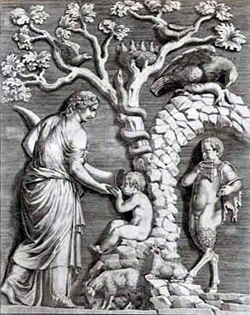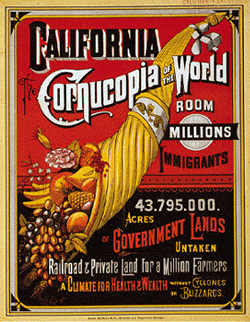16. The Cornucopia

Illustration 12: Amalthea feeds Zeus from the horn
Just like Christmas and Easter, Thanksgiving has one major pagan symbol, the cornucopia. But unlike the Christmas tree or the Easter bunny, the cornucopia is linked directly to both Greek and Roman pagan Gods. There is a plethora of evidence that supports the fact that the cornucopia was in frequent use and display during Christ's time on earth, and it's unlikely that the cornucopia would have mistaken for anything but a pagan symbol.It is the proud symbol of the nation's prosperity and good fortune.
Federal Reserve Bank of San Francisco
noun
1. abundance: a great abundance of something
2. arts goat's horn overflowing with produce: a painting or other representation of a goat's horn overflowing with fruits, flowers, and vegetables, used to symbolize plenty or prosperity
3. horn-shaped container: an ornament or container shaped like a goat's horn
4. mythology horn of goat that suckled Zeus: in Greek mythology, the horn of the goat that suckled Zeus
Cornucopia, Latin for "horn of plenty," in Greek mythology, one of the horns of the goat Amaltheia, which was caused by Zeus to refill itself indefinitely with food and drink. In paintings the cornucopia is depicted as a horn-shaped container spilling over with fruit and flowers.
Microsoft ® Encarta ® 2006
Many of the images commonly associated with Thanksgiving are derived from much older traditions of celebrating the autumn harvest. For example, the cornucopia (a horn-shaped basket overflowing with fruits and vegetables) is a typical emblem of Thanksgiving abundance that dates to ancient harvest festivals. Many communities also decorate their churches with fruits, flowers, and vegetables at Thanksgiving, much as European communities have for centuries during the autumn harvest season.
Microsoft ® Encarta ® 2006
The Cornucopia (Latin, 'horn of plenty'), a spiraling, woven basket overflowing with an abundance of produce, is an ever-present symbol of harvest prosperity. The symbol dates back to an ancient tale of the Nymph Amalthea,* who, as a reward from the infant Zeus for a meal of Goat's milk, was given an enchanted goat's horn which gave whatever one wished for. The cornucopia became a ubiquitous symbol of fotune and plenty, and was associated with many Goddesses, including Fortuna, the goddess of good fortune, and Ceres, Goddess of agriculture.
*Sometimes, Amalthea herself is the goat.
About.com1

The cornucopia (Latin: Cornu Copiae) is a symbol of food and abundance dating back to the 5th Century BC, also referred to as Horn of Plenty, Horn of Amalthea, and harvest cone.
In Greek mythology, Amalthea raised Zeus on the milk of a goat. In return Zeus gave Amalthea the goat's horn. It had the power to give to the person in possession of it whatever he or she wished for. This gave rise to the legend of the cornucopia. The original depictions were of the goat's horn filled with fruits and flowers: deities, especially Fortuna, would be depicted with the horn of plenty.
In modern depiction, the cornucopia is typically a hollow, horn-shaped wicker basket typically filled with various kinds of festive fruit and vegetables. In North America, the cornucopia has come to be associated with Thanksgiving and the harvest.
http://en.wikipedia.org/wiki/Cornucopia

Illustration 13: Cornucopia on American currency. http://www.frbsf.org/currency/iconography/cornucopia.html
The exact reasons for the cornucopia to be attached to Thanksgiving day, at this point, is not fully understood. But there is plenty of evidence to suggest why it happened, as it's been a part of our society for a long time. The Federal Reserve lists the cornucopia as a general symbol used in our money.
The cornucopia is a common symbol representing abundance and prosperity. It's a part of our society.A curved goat's horn overflowing with fruits and grains has been a popular element in the design of paper money. Called the cornucopia, this curious design element represents the horn of the Greek nymph Amalthea. Legend says that her magical container rewarded its possessor's every wish.
Sometimes called the "horn of plenty," the cornucopia appears in the corners and on the edges of many of our banknotes. It is the proud symbol of the nation's prosperity and good fortune.
American Currency Exhibit, Federal Reserve Bank
Federal Reserve Bank of San Francisco2

Illustration 14: Persephone and Hades Ploutos (with cornucopia): tondo of an Attic red-figured kylix, ca. 440–430 BCE.
http://en.wikipedia.org/wiki/Hades
Greek and Roman Gods; Abundantia, Achelous, Amalthea, Annona, Aequitas, Astarte, Bacchus, Britannia, Bona Dea, Ceres, Concordia, Copia, Decima (Parcae), Demeter, Dionysus, Eirene, Euthemia, Fecunditas, Felicitas, Fortuna, Genius, Hades, Heracles, Hercules, Hilaritas, Hygieia, Jupiter, Lachesis, Laetitia, Liberalitas, Matrones, Moneta, Nemesis, Pax, Pietas, Pluto, Ploutos, Providentia, Pudicitia, Roma, Salus, Spes, Tiberinus, Tyber, Tyche, Zeus.
Celtic gods Erecura, Cernunnos, Matres
Gallo-Roman: Epona,
Jesus and the Cornucopia

Illustration 15: Livia, wife of Augustus; a life-size statue with attributes of Ceres (floral crown, wheat sheaves, cornucopia). Roman, Tiberian era.
Illustration 18: RIC 126, BMC 347, S 1592 AR Denarius Obv: No legend - Bare head right.Rev: No legend Exe: AVGVSTVS - Capricornus advancing right, bearing globe and cornucopia. 18-16 BC
And it came to pass in those days that a decree went out from Caesar Augustus that all the world should be registered.
Luke 2:1
"Show Me the tax money." So they brought Him a denarius. And He said to them, "Whose image and inscription is this?" They said to Him, "Caesar's." And He said to them, "Render therefore to Caesar the things that are Caesar's, and to God the things that are God's."
Matthew 22:19-21
"Shall we pay, or shall we not pay?" But He, knowing their hypocrisy, said to them, "Why do you test Me? Bring Me a denarius that I may see it." So they brought it. And He said to them, "Whose image and inscription is this?" They said to Him, "Caesar's." And Jesus answered and said to them, "Render to Caesar the things that are Caesar's, and to God the things that are God's." And they marveled at Him.
Mark 12:15-17
Illustration 16: RIC 130 Augustus Denarius. Spain, 18-16 BC. Bare head left / Capricorn flying right with cornucopiae on its back and holding a globe attached to a rudder, AVGVSTVS below.Now in the fifteenth year of the reign of Tiberius Caesar...Illustration 17: RIC 252, BMC 605, C 69 Denarius Obv: No legend - Bare head of Octavian right.Rev: CAESAR DIVIF - Draped Pax standing left, holding olive-branch and cornucopia. c.32-29 BC
Luke 3:1
Examples of a Denarius with Caesar's face on one side, and the cornucopia on the other. Though because of the abundance of other types of coins, it's perhaps unlikely that the coin Jesus specifically referred to was one of these."Show Me a denarius. Whose image and inscription does it have?" They answered and said, "Caesar's." And He said to them, "Render therefore to Caesar the things that are Caesar's, and to God the things that are God's."
Luke 20:24-25
The Cornucopia was probably the most commonly used symbol on Imperial denarii.
http://www.forumancientcoins.com/moonmoth/reverse_abundantia.html